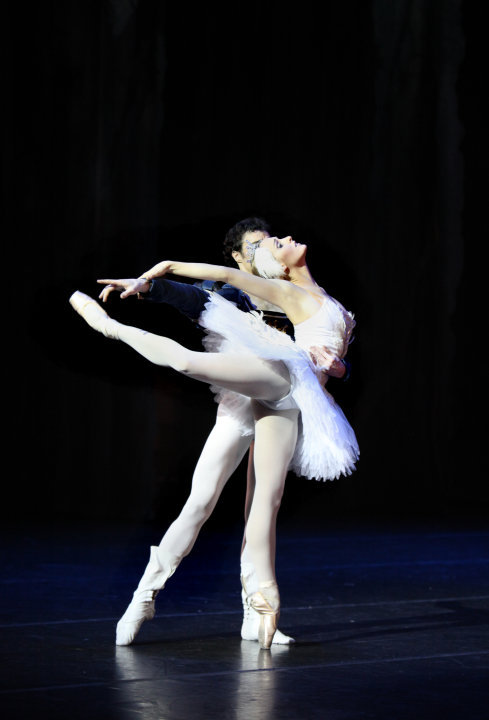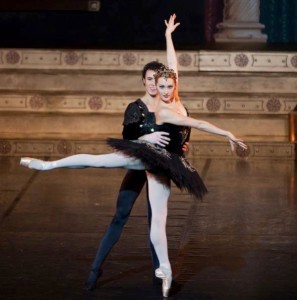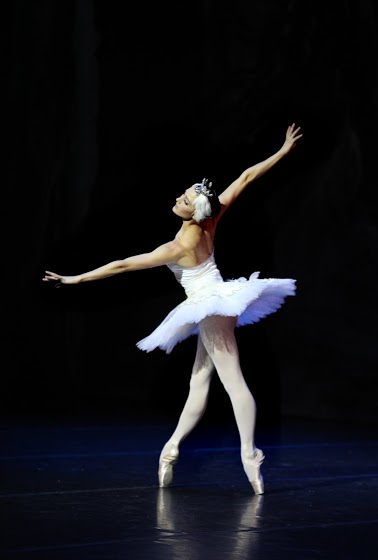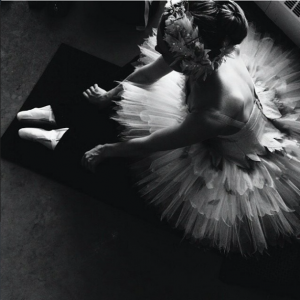
Today Boston Ballet‘s Ashley Ellis joins us to talk about how she gets ready to dance the classic ballet Swan Lake. Read more from her in the coming months as she authors posts for us as a contributing writer to the site…
Dancing the role of Odette/Odile is an incredible challenge for any dancer. What steps do you take to prepare your body for this role?
Dancing the dual role of Odette/Odile is a challenge in various ways. There is the obvious technical challenge that most full-length classical ballets demand. However, Swan Lake is different in that to dance this ballet the ballerina is required to portray two characters that are completely opposite of one another.
When preparing to dance either Odile or Odette I like to start with my arms. The style of the upper body is quintessential to becoming a swan. Like with dancing any role, but especially Odette/Odile, I like to spend a bit of time before rehearsal or a show just to gear my body up for the specific style it will have to feel. I go through the movements so that when I have to dance it feels more organic. When I enter in the second act I don’t want to have to think about if my arms are making the right lines, I want to think about how I feel at that moment with my partner and the music.
So until I feel that I have these extreme and sometimes contorted positions feeling more organic in my own body I am constantly checking in the mirror to see what line the public will see. For me this comes with time as I’m working on the role. Each day my muscles remember more and I have to think less about the positions.
Then it is important to build stamina, so as we approach the shows, I like to run each act to build strength.

What do you do to make each character (Odette and Odile) unique?
Each swan, the white and the black, the good and the evil, represents a completely opposite identity from the other. I try to embody the characteristics of each and do my best not to let them bleed together. I take on each role and try to let them shine through my movements. For example, Odette is a kind spirit, embodying love. However she is not weak, she is still a proud swan queen.
Odile on the other hand shows up in the 3rd act with Von Rothbart and carries out her actions under his command. Her mission is to trick the prince into swearing his love for her. To bring this role to life I try to use my eyes and more commanding movement to show strength and lure the prince in.
It does require a moment though to calm down going into 4th act after running off stage from the high of dancing the black swan–especially because in this act Odette is heartbroken.
When getting coached by the incredible, Larissa Ponomarenko, she constantly reminds me as I execute my steps that although I may be creating an esthetically pleasing classical line with my arms, that I look human, and “at this moment you are a swan.”
What is your rehearsal schedule like for this ballet?
Well, at Boston Ballet we are often working on various ballets at the same time. We just finished putting together Lady of the Camellias as well as various shorter pieces for later in the season. So things can get a little bit crazy, and some days going from contemporary into classical makes it especially challenging. The most important thing is to go into each rehearsal focused on the role to be mastered. So much of dance is about being mentally prepared.
As we get closer to the performances I like to run the ballet in order, beginning with second act and going to black and then back to white. It is so important to build stamina. It’s funny because I find that I tend to stress about not having stamina, but I know in the end I will get there. The feeling of not being able to get through a variation, ballet, or whatever is so daunting. It’s never easy, but it can get easIER.

You have danced Swan Lake before, but Petipa’s version. How is Mikko Nissinen’s version different?
Like the version I danced previously, Mikko’s has the same classical base, with variations in the steps that he has chosen to apply to make it his own. I do find it interesting to see how the ending changes from version to version; if they die, or live happily after, or in some, they even die and then rise up into the clouds. I don’t think I’m supposed to reveal the ending of this version because it is NEW, and he probably wouldn’t like it if I spilled the beans. Haha!
There are many beautiful, interesting, and original touches in Robert Perdziola’s design and it is sure to be stunning. I can’t wait to see the production on stage; I know it will definitely be worth coming to see.
Swan Lake has such beautiful music. Is there a particular section of the score that you find you gravitate toward?
One of my favorite moments is the introduction to the Black Swan Pas de deux. The music begins while we are still off stage and then we fly on from the wing together. From the very beginning it gives me such a feeling of strength and command.
In terms of your pointe shoes – how do you prepare them for Swan Lake, and how many pairs will you use in a performance?
I definitely want good shoes, and will most likely wear a different pair for each act. Not a new pair for each act, because they will be broken in and worn just enough that they are ready to provide what I need. They have to have good support because there is so much technical dancing throughout the whole ballet.
As Odette I like to have supportive shoes but they should be well broken in. There is a lot of running around as well as movement that is very controlled so I need to be able to really feel the floor. As Odile I can wear a slightly harder pair. There are a lot of turns throughout the pas, variation, and coda and I need to know they will support me until the end.

What do you find to be the most difficult part of dancing this ballet, and what do you do to cope with it?
The stamina is quite hard, but it is more than just doing the steps and getting through to the end. It is so important to make everything seamless, while maintaining your portrayal of a swan, and on top of that telling a story. So the hardest part is doing all of this at once. I find that the best way to achieve this is to spend time on it.
It sounds simple, but spending time moving like a swan and listening to the music, and thinking of how the character feels at that moment within the ballet is the best way for me to prepare.
What is the thing that you enjoy most about dancing this ballet?
I love dancing both Odette and Odile so much, the challenge to becoming both is quite exciting. I love various aspects of becoming each character. On a physical level, although the dancing is very classical, the style feels quite freeing. Also, for me the music really brings both characters to life. You can really hear the emotions through each composition; from the tranquil feeling of Odette when she is all alone in her entrance to how frantic she is when the prince startles her, to the second act pas where she is falling in love, but is torn because of the spell cast on her. Tchaikovsky carries you through all of these emotions. Then for Odile, I feel thrown at a high speed onto the stage with the entrance of the 3rd act pas; the music screams grandeur and power.
Boston Ballet will be performing Mikko Nissinen’s Swan Lake from October 30th through November 16th. See Ashley Ellis bring Odette and Odile to life on stage. View the rest of the company’s offerings for the season here.

Contributing writer Ashley Ellis is a principal dancer at Boston Ballet. Ellis hails from Torrance, California and she received her dance training at the South Bay Ballet under the direction of Diane Lauridsen. Other instruction included Alicia Head, Mario Nugara, Charles Maple, and Kimberly Olmos.
She began her professional career with American Ballet Theatre’s Studio Company and later joined American Ballet Theatre as a company dancer. In 1999, Ellis won the first prize at the Los Angeles Music Center Spotlight Award, and went on to become the recipient of the Coca Cola scholarship award in 2000 and 2001. She has performed in Spain with Angel Corella’s touring group and joined Corella Ballet in 2008 as a soloist. In 2011, Ellis joined Boston Ballet as a second soloist. She was promoted to soloist in 2012 and principal dancer in 2013.
Her repertoire includes Marius Petipa’s The Sleeping Beauty; Mikko Nissinen’s The Nutcracker; Natalia Makarova’s La Bayadère; Marius Petipa’s Swan Lake; Christopher Wheeldon’s DGV: Danse à Grande Vitesse, VIII and Polyphonia; Harald Lander’s Études; Michel Fokine’s Les Sylphides; Rudolf Nureyev’s Don Quixote; Christopher Bruce’s Rooster; George Balanchine’s Serenade, Coppélia, Symphony in Three Movements, Symphony in C, and Tchaikovsky Pas de Deux; Clark Tippet’s Bruch Violin Concerto; Twyla Tharp’s In the Upper Room; Stanton Welch’s Clear; Angel Corella’s String Sextet; Wayne McGregor’s Chroma; Jorma Elo’s Awake Only; Jerome Robbins’ Fancy Free; Jiří Kylián’s Wings of Wax, Symphony of Psalms, and Petite Mort.





